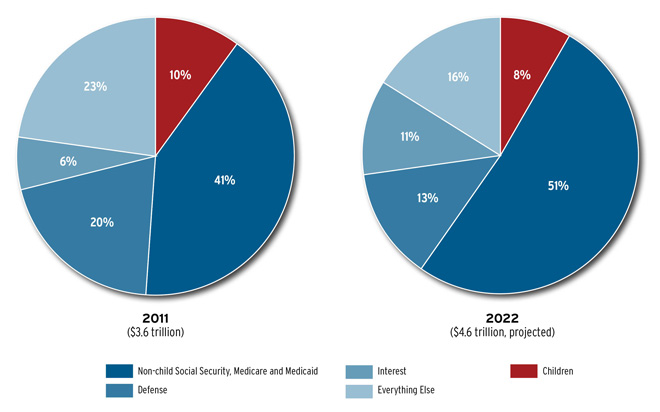Federal spending on children fell for the first time since the early 1980s, according to the recent Urban Institute report, “Kids’ Share 2012: Report on Federal Expenditures on Children through 2011.” An even larger decrease is projected for fiscal year 2012, with the largest declines in federal education programs. Gloomy forecasts through 2022 show federal outlays on children falling from 10 to 8 percent of the federal budget and also falling as a share of the economy, from 2.5 to 1.9 percent of GDP, below the pre-recession level of investment.
Why this downward trend? In the short run, the decline is driven by the exhaustion of funding from the American Recovery and Reinvestment Act of 2009. While expected, the loss of these temporary funds comes at a hard time. Many families still face economic hardships in the wake of the recession. States and localities have been hard hit by the recession and will be severely challenged to make up for this decrease.
Moreover, the drop in spending on children is not part of a general belt-tightening. In fact, total federal outlays increased by nearly $80 billion last year, after adjusting for inflation. Bottom line: it is the share of the budget spent on children, not federal spending as a whole, that is falling.
Over the longer term, structural forces in the federal budget are placing a squeeze on spending on children. Specifically, as the retired population grows and health costs continue to rise, spending on Medicare, Medicaid, and Social Security is increasing so dramatically that more than half (51 percent) of the federal budget is projected to be spent on these entitlement programs by 2022. At the same time, federal revenues fall short of federal spending levels every year, resulting in a growing debt. By 2017, we will be spending more on interest payments than on children. With automatic growth driving spending for more than 60 percent of the budget, competition will be fierce for the remaining share.
While current projections suggest that the kids’ share of the budget will drop from 10 to 8 percent, the future could be even more grim. These projections assume that the spending caps in the Budget Control Act are followed—and defense spending is actually cut from 20 to 13 percent of the budget and “all other spending” (e.g., agriculture, commerce, the environment, transportation, etc.) declines from 23 to 16 percent (see figure below).
Kids Slated to Get Declining Share of Federal Budget

Children’s programs might be cut more radically if the Budget Control Act were replaced with a budget package that cuts less from defense and more from non-defense programs. Or a package that dropped the current exemption of low-income programs from automatic budgetary sequestration (an exemption that serves to protect many children’s programs). On the other hand, children’s programs would fare better if we had the political will to consider not just spending cuts, but also revenue increases, and if broad budget packages included proposals to stem the growth in Social Security and Medicare while still protecting current recipients dependent on those benefits.
Let’s build a future where everyone, everywhere has the opportunity and power to thrive
Urban is more determined than ever to partner with changemakers to unlock opportunities that give people across the country a fair shot at reaching their fullest potential. Invest in Urban to power this type of work.